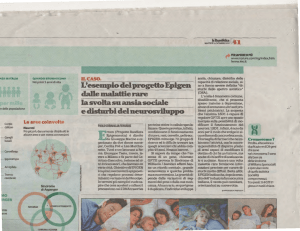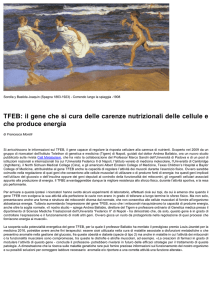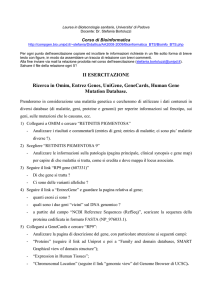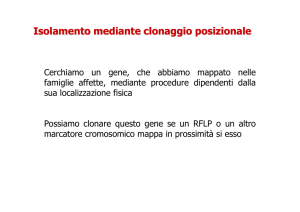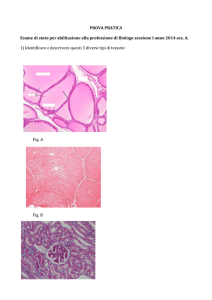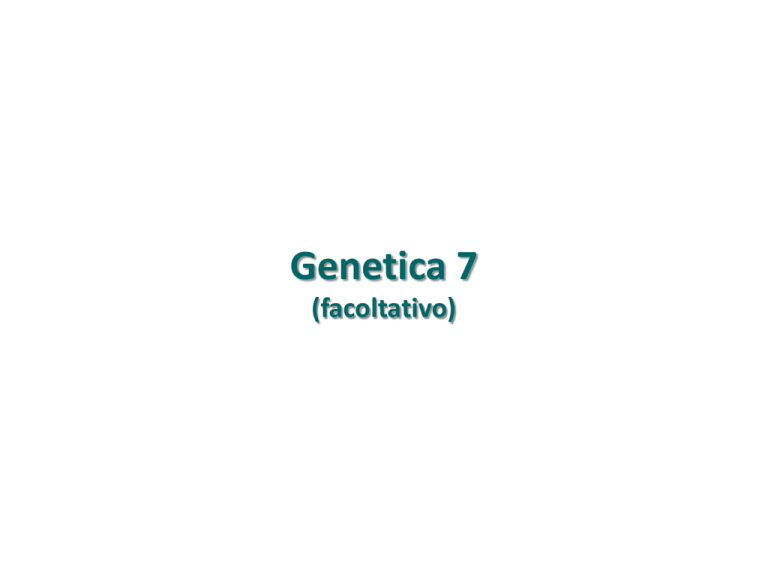
Genetica 7
(facoltativo)
Classificazione delle malattie ereditarie
• Mendeliane (mutazione di singoli geni con ampio effetto)
• Multifattoriali (genetici e ambientali)
• Malattie da singolo gene con trasmissione non mendeliana (ex. espansione da
triplette, malattie mitocondriali)
11% of the genes in the genome are tested for
clinically today
Monogenic diseases
Majority of disease risk by single gene
Epigenetic disease(>1 gene + environment)
Tay Sachs (100%)
100%
Cystic Fibrosis (100%)
Breast Cancer (40-80%)
Cardiomyopathy (55%)
50%
Type 2 Diabetes (25% to 33%)
- 1.35 fold increase
0%
Alzheimer’s Disease (1.18% to 5.89%)
- 5 fold increase
Scientists currently estimate that over 10,000 of human diseases are known to be monogenic.
The single-gene or monogenic diseases can be classified into three main categories:
• Dominant
• Recessive
• X-linked
Dominant and recessive diseases are monogenic disorders that involve damage to only one gene copy.
X linked diseases are monogenic disorders that are linked to defective genes on the X chromosome.
Monogenic diseases are responsible for a heavy loss of life. it has been estimated that taken together,
monogenic diseases may account for up to 40% of the work of hospital based pediatric practice (Scriver,
1995).
Thalassaemia
Sickle cell anemia
Haemophilia
Cystic Fibrosis
Tay sachs disease
Fragile X syndrome
Huntington's disease
http://www.who.int/genomics/public/geneticdiseases/en/index2.html
Genes and Disease
National Center for Biotechnology Information (US)
Bethesda (MD): National Center for Biotechnology Information (US); 1998-.
Genes and Disease is a collection of articles that discuss genes and the diseases that they cause. These
genetic disorders are organized by the parts of the body that they affect. As some diseases affect various
body systems, they appear in more than one chapter.
With each genetic disorder, the underlying mutation(s) is discussed, along with clinical features and
links to key websites. You can browse through the articles online, and you can also download a printable
file (PDF) of each chapter.
From Genes and Disease you can delve into many online related resources with free and full access. For
example, you can visit the human genome to see the location of the genes implicated in each disorder.
You can also find related gene sequences in different organisms. And for the very latest information, you
can search for complete research articles, and look in other books in the NCBI Bookshelf.
Currently over 80 genetic disorders have been summarized, and the content of Genes and Disease is
continually growing.
http://www.ncbi.nlm.nih.gov/books/NBK22183/
Online Mendelian Inheritance in Man (OMIM; http://www.omim.org) lists the following phenotypes with
Mendelian patterns of inheritance (reflecting mutations at a single locus):
Single-gene disorders represent one of the three major categories of genetic disease. Mutations of
single genes have been documented at almost 20% of the 22.000 genetic loci in the human genome
that code for protein products.
Single Gene Defects
(monogenic diseases)
Human Genes and Genomes
Leon E. Rosenberg and Diane Drobnis Rosenberg
Academic Press
ISBN 978-0-12-385212-0
Copyright © 2012, Elsevier Inc. All
rights Reserved.
Sir Archibald Garrod, the british physician who
created the field of human biochemical genetics
in 1902 by his study of alkaptonuria
Alkaptonuria
is
an
autosomal
recessive
aminoacidopathy characterized by accumulation of
homogentisic acid (alkapton) in the urine resulting
from congenital lack of the enzyme homogentisate
1,2-dioxygenase, which mediates an essential step in
the catabolism of phenylalanine and tyrosine. It is
manifested
by
elevated
concentrations
of
homogentisic acid in the urine (which darkens on
standing or with alkalinization), a peculiar
discoloration of body tissues known as ochronosis,
and arthritis.
We now know that it is caused by mutation in the
homogentisate 1,2-dioxygenase gene (HGD) on
chromosome 3q.
Copyright © 2012, Elsevier Inc. All rights Reserved.
Examination of the structure of homogentisic acid, with its six-carbon phenyl ring,
suggested to Garrod that it might be related to the amino acid phenylalanine and tyrosine,
each with a phenyl ring as a major substituent.
Therefore, Garrod embarked on a series of feeding experiments in alkaptonuric patiens
and in healthy controls
• He fed homogentisic acid to patients and controls. Patients excreted all they ingested
in the urine, controls excreted none
• He fed phenylalanine and tyrosine to patients and controls. Homogentisic acid
excretion increased markedly in patients, controls excreted none
Copyright © 2012, Elsevier Inc. All rights Reserved.
Garrod proposed that homogentisic acid was an intermediate in the
pathway through which phenylalanine and tyrosine are broken down.
He went on to propose that there must be an enzyme responsible for
this breakdown of homogentisic acid and that enzyme was deficient in
people with alkaptonuria
He noted that affected patients were not infrequently the offsprings of
first cousins or other consanguinous matings
Fortuitously, he consulted William Bateson (who coined the word
“gene”, which means “giving birth to” and the two men realized that
alkaptonuria was behaving like a rare Mendelian recessive.
The defect was narrowed down to homogentisic acid oxidase (HGD)
deficiency in a study published in 1958. The genetic basis was
elucidated in 1996, when HGD mutations were demonstrated
Copyright © 2012, Elsevier Inc. All rights Reserved.
Panorama of single-gene defects
Collectively, these mutations cause
dysfunction of every class of protein
present in human cells – structural,
enzymatic,
circulatory,
membrane,
transcriptional regulators etc. – and that
these dysfunctions have been observed in
every tissue and every cell type.
Some of these disorders are inherited as
dominants traits, others are recessive,
and still others are X-linked or
mitochondrial.
Copyright © 2012, Elsevier Inc. All rights Reserved.
About one-third of these inborns errors
are clinically harmless, another third
result in severe dysfunction, and the
remainder cause mild or moderate
abnormalities
On the right: clinical consequenses of
332 well characterized inborn errors of
meabolism
Copyright © 2012, Elsevier Inc. All rights Reserved.
Hemoglobinopathies
Hemoglobin (Hb) is the iron-containing oxygentransport metalloprotein in the red blood cells
of all vertebrates (with the exception of the fish
family Channichthyidae) as well as the tissues of
some invertebrates.
In mammals, the protein makes up about 97%
of the red blood cells' (RBCs) dry content (by
weight).
Hemoglobin is a tretramer: two alpha and two
beta globin chains. Each globin chain contains a
heme molecule
Copyright © 2012, Elsevier Inc. All rights Reserved.
The human genome has 13 globin genes:
• 4 pseudogenes and 1 locus of unknown function
• The alpha genes are on chromosome 16.
• The beta genes are on choromome 11
Copyright © 2012, Elsevier Inc. All rights Reserved.
Time course of production of the several globin chains
Copyright © 2012, Elsevier Inc. All rights Reserved.
Beta globin gene: only 1,6 Kb, composed of 3 exons and 2 introns. Gene expression controlled by a
number of sequence motifs at or near the 5’ end of the gene (promoter + transcription factor sites)
Primary transcript edited by the usual addition of the cap site and of the polyA tail. Then, the
transcript is spliced and the 2 introns are removed. The 3 exons are joined together to make beta-globin
mRNA that exit the nucleus and is translated on cytoplasmic ribosomes to form the beta-globin protein,
which contains 146 amino acid residues
Copyright © 2012, Elsevier Inc. All rights Reserved.
How the gene was located and dissected to provide
the info shown in the previous figure?
By functional cloning: the process begins
with the disease phenotype, moves to the
protein responsible for the function, and
then uses information about the protein
(and its mRNA) to finally isolate the gene
Copyright © 2012, Elsevier Inc. All rights Reserved.
1. Isolate cells making the protein of interest
2. Obtain the mRNA for that protein
3. Reverse transcribe that mRNA
4. Purify the single-stranded complementary
DNA (cDNA) product, and convert it to
double strand
5. Hybridize the cDNA to a library of DNA
fragments representing the entire human
genome
6. Sequence the identified fragment to finally
produce the complete structure of the gene
Copyright © 2012, Elsevier Inc. All rights Reserved.
Missense mutations «pock mark» the
hemoglobin subunits. More than 75% in
each chain have undergo substitutions.
They often affect hemoglobin’s ability to
form tetramers, carry oxygen or stability
Red circles
Amino acid residues at which functionally
significant missense mutations have been
observed
Open circles
Missense mutations of
functional significance
little
or
no
Frameshift mutations produce mRNA that
is not translated properly, but their
functional consequences depends on
where the frameshift occurs in the mRNA
Copyright © 2012, Elsevier Inc. All rights Reserved.
http://www.who.int/genomics/public/Maphaemoglobin.pdf
Sickle Cell Anemia
In 1949 it became the first human disease to be understood at molecular level by Nobel Prize-winner
Linus Pauling. It was the first disease in which the beta-globin chain was sequenced and a single
amino acid substitution was shown. It was also the first human genetic system proving that the
triplet genetic code was the same in humans as in simpler model organisms
Normal red blood cells live about 120 days in the bloodstream, but sickled red cells die after about 10
to 20 days. Because they cannot be replaced fast enough, the blood is chronically short of red blood
cells, leading to a condition commonly referred to as anemia.
Copyright © 2012, Elsevier Inc. All rights Reserved.
Sickle cell anemia is caused by an abnormal type of
hemoglobin called hemoglobin S.
Hemoglobin S is caused by a SNP in the 6° codon of
the beta-globin gene (GAG -> GTG) leading to a
glutamic acid to valine change often abbreviated
Glu6Val. It is inherited as an autosomal recessive
trait. Homozygotes (SS) almost always have serious
clinical problems, whereas heterozygotes (AS) are
usually healthy
The Glu6Val mutation changes hemoglobin tetramers
such that when deoxygenated in the tissues, they
become insoluble and aggregate.
The prevalence of this disease varies among
populations in direct relatioship with malaria: in
Nigeria 1 in 50 people has the SS genotype
Statistics: sickle cell anemia occurs in 1/500 African
Americans, 1/150.000 Europeans, 1/200.000 Asians
Copyright © 2012, Elsevier Inc. All rights Reserved.
Haemophilia
Haemophilia is a hereditary bleeding disorder, in which there is a partial or total lack of an essential
blood clotting factor. It is a lifelong disorder, that results in excessive bleeding, and many times
spontaneous bleeding, which, very often, is internal. Haemophilia is an X-linked recessive genetic
pattern and is more common in males than females
There are mainly two types of Haemophilia, they are Haemophilia A and Haemophilia B.
Rarely there is another type of haemophilia known as haemophilia C.
• Haemophilia A is caused by the deficiency of clotting factor VIII
• Haemophilia B is caused by the deficiency of clotting factor IX (Christmas Factor)
• Haemophilia C is caused by the deficiency of clotting factor XI. In all the above cases,
patient will have abnormal bleeding tendency.
Incidence
• Haemophilia A: 1:5000 males. It is four times more common than Type B.
• Haemophilia B: 1: 34,000 Males.
Haemophilia in girls is very rare condition. This condition develops in girls only when both
the X genes are defective. If a girl has one defective X gene and a normal X gene, she is not
affected but her male children have 50% chance of getting the disease.
Cystic Fibrosis
Cystic fibrosis (CF), also known as mucoviscidosis, is an autosomal recessive genetic disorder
that affects most critically the lungs, and also the pancreas, liver, and intestine. It is
characterized by abnormal transport of chloride and sodium across an epithelium, leading
to thick, viscous secretions. Difficulty breathing is the most serious symptom and results
from frequent lung infections that are treated with antibiotics and other medications. Other
symptoms—including sinus infections, poor growth, and infertility—affect other parts of the
body.
CF is caused by a mutation in the gene for the protein cystic fibrosis transmembrane conductance
regulator (CFTR). This protein is required to regulate the components of sweat, digestive fluids, and
mucus. CFTR regulates the movement of chloride and sodium ions across epithelial membranes, such
as the alveolar epithelia located in the lungs.
Both CFTR copies must be missing for CF to develop, and therefore has autosomal recessive
inheritance.
CF is most common among people of Central and Northern European ancestry, but occurs in many
demographic groups around the world. The prevalence of CF is the rarest in Asia and the Middle East.
Individuals with cystic fibrosis can be diagnosed before birth by genetic testing, or by a sweat test in
early childhood. Ultimately, lung transplantation is often necessary as CF worsens.
Although it is severely underdiagnosed in Asia, existing evidence indicates that the prevelance of CF is
rare. In the European Union 1 in 2000-3000 new borns is found to be affected by CF. In the United
States of America the incidence of CF is reported to be 1 in every 3500 births.
http://www.who.int/genomics/publications/en/HGN_WB_04.02_fig2.pdf
Tay sachs disease
Tay-Sachs disease is an autosomal recessive disease in
which harmful quantities of a fatty substance called
Ganglioside GM2 accumulate in the nerve cells in the
brain, leading to paralysis, dementia, blindness,
psychoses, and even death.
Tay-Sachs is caused by mutations in both alleles of a
gene (HEXA) on chromosome 15. HEXA codes for the
alpha subunit of the enzyme β-hexosaminidase A. This
enzyme is found in lysosomes, organelles that break
down large molecules for recycling by the cell.
Normally, β-hexosaminidase A helps to degrade a lipid
called GM2 ganglioside, but in Tay-Sachs individuals, the
enzyme is absent or present only in very reduced
amounts, allowing excessive accumulation of the GM2
ganglioside in neurons.
The progressive neurodegeneration seen in the varied
forms of Tay-Sachs depends upon the speed and degree
of GM2 ganglioside accumulation, which in turn is
dependent upon the level of functional βhexosaminidase A present in the body.
This disease is autosomal recessive.
Prevalence:
The frequency of the condition is much higher in Ashkenazi Jews of Eastern European origin than in
others.
Approximately one in every 27 Jews in the United States of America is a carrier of the TSD gene.
There is also a noticeable incidence of TSD in non-Jewish French Canadians living near the St. Lawrence
River and in the Cajun community of Louisiana. By contrast, the carrier rate in the general population
as well as in Jews of Sephardic origin is about one in 250.
Among Jews of Sephardic origin and in the general, non-Jewish population, the carrier rate is about 1
in 250. There are certain exceptions. French-Canadian and the Cajun community of Louisiana have the
same carrier rate as Ashkenazi Jews, one in 27. Also, individuals with ancestry from Ireland are at
increased risk for the Tay-Sachs gene. Current research indicates that among Irish Americans, the
carrier rate is about one in 50.
Fragile X syndrome
Fragile X syndrome is the most common inherited form of mental retardation
currently known. Fragile X syndrome is a defect in the X chromosome and its
effects are seen more frequently, and with greater severity, in males than
females.
In Fragile X individuals, there is a mutation in one end of the FMR1 gene (the 5'
untranslated region), consisting of an amplification of a CGG repeat. Patients
with fragile X syndrome have 200 or more copies of the CGG motif. The huge
expansion of this repeat means that the FMR1 gene is not expressed, so no
FMR1 protein is made. Although the exact function of FMR1 protein in the cell is
unclear, it is known that it binds RNA.
A similar nucleotide repeat expansion is seen in other diseases, such as
Huntington disease.
Although it is a X-linked recessive trait with variable expression and incomplete penetrance,
30% of all carrier women are affected.
Prevalence:
According to the Fragile X association of Southern California, Fragile X syndrome is the single
most common inherited cause of mental impairment affecting 1 in 3600 males and 1 in 4000
to 6000 females with full mutation worldwide.
Some studies also suggest that fragile X affects 1 in every 2000 males and 1 in every 4000
females of all races and ethnic groups.
Studies have also revealed that 1 in 259 women of all races carry fragile X. The number of men
who are carriers is thought to be 1 in 800 of all races and ethnicity. Carrier females have a 30%
to 40>% chance of giving birth to a retarded male child and a 15 to 20% chance of having a
retarded female.
Huntington disease
Huntington disease (HD) is an inherited, degenerative neurological disease that leads to dementia.
About 30,000 Americans have HD and about 150,000 more are at risk of inheriting the disease from a
parent.
The HD gene, whose mutation results in Huntington disease, was mapped to chromosome 4 in 1983 and
cloned in 1993. The mutation is a characteristic expansion of a nucleotide triplet repeat in the DNA
that codes for the protein huntingtin.
Since people who have those repeats always suffer from Huntington disease, it suggests that the
mutation causes a gain-of-function, in which the mRNA or protein takes on a new property or is
expressed inappropriately.
With the discovery of the HD gene, a new predictive
test was developed that allows those at risk to find
out whether or not they will develop the disease.
Animal models have also been developed, and we
know that mice have a gene that is similar to the
human HD gene.
As the number of repeated triplets - CAG - increases, the age of onset in the patient decreases.
Furthermore, because the unstable trinucleotide repeat can lengthen when passed from parent to
child, the age of onset can decrease from one generation to the next.
Copyright © 2012, Elsevier Inc. All rights Reserved.
Huntington's is an autosomal dominant genetic disorder which means that if one parent carriers the
defective Huntington's gene, his/her offspring have a 50/50 chance of inheriting the disease. Everyone
who carries the gene will develop the disease.
Prevalence:
Huntington's disease (HD) affects males and females equally and crosses all ethnic and racial
boundaries. It typically begins in mid-life, between the ages of 30 and 45, though onset may occur as
early as the age of 2. Children who develop the juvenile form of the disease rarely live to adulthood.
In Western countries, it's estimated that about 5 to 7 people per 100,000 are affected by HD.
Duchenne Muscular Dystrophy
Muscular dystrophy (MD) is a group of muscle diseases that weaken the
musculoskeletal system and hamper locomotion. Muscular dystrophies are
characterized by progressive skeletal muscle weakness, defects in muscle proteins,
and the death of muscle cells and tissue.
Duchenne muscular dystrophy (DMD) is the most common form of muscular
dystrophy among children. DMD occurs among approximately 1 in 3500 male
births. This broad range reflects studies of different groups of individuals around
the world. Usually, a person with DMD loses the ability to walk sometime during
the period when he or she is 7 through 13 years of age, and can live into their 20s
and 30s.
Becker muscular dystrophy (BMD) is a milder form of muscular dystrophy. BMD
affects about 1 in 18,500 male births. Signs of BMD are similar to those for DMD.
Typically, people with BMD lose the ability to walk after they are 16 years of age.
Together, DMD and BMD are called Duchenne/Becker muscular dystrophy (DBMD). Over time, the
muscles of people with DBMD get much weaker because the lack of the dystrophin protein in muscle
cells causes them to be fragile and easily damaged
Thanks to advances in cardiac and respiratory care, life expectancy is increasing and many young adults
with DMD attend college, have careers, get married and have children. Survival into the early 30s is
becoming more common, and there are cases of men living into their 40s and 50s
Duchenne muscular dystrophy is caused by mutations in
DMD gene which codes for protein dystrophin. DMD gene is
located on the short arm of the X chromosome (Xp21.2p21.1)
DMD is inherited in an X-linked recessive pattern. Females
will typically be carriers for the disease while males will be
affected. Typically, a female carrier will be unaware they
carry a mutation until they have an affected son.
The son of a carrier mother has a 50% chance of inheriting
the defective gene from his mother. The daughter of a carrier
mother has a 50% chance of being a carrier or having two
normal copies of the gene. In all cases, the father will either
pass a normal Y to his son or a normal X to his daughter.
Female carriers of an X-linked recessive condition, such as
DMD, can show symptoms depending on their pattern of Xinactivation.
The Dystrophin gene responsibile for the disease was
identified by positional cloning.
It was known that the casual gene was on the X
chromosome because the disease was inherited as an
X-linked trait. Linkage studies had placed it somewhere
on the short arm (p) which is 60 Mb and encodes 400
genes
Therefore, the researchers went from disease to its
map position on the chromosome to identification of
the gene and then to defining its function
Copyright © 2012, Elsevier Inc. All rights Reserved.
Dystrophin is the largest human gene, about 2.3 million bases (Mb) long. It contains 79 exons and
occupies more than 1% of the X chromosome. The dystrophin protein is extremely large as well: 420
kiloDaltons (kDa).
Dystrophin is involved in the contractile apparatus of muschle proteins, where it interacts with the
cytoskeleton. The majority of mutations in DMD patiens are large or small deletions that affect the
reading frame in the dystrophin gene
Copyright © 2012, Elsevier Inc. All rights Reserved.
Detection of dystrophin by immunofluorescence. Note the intense staining around the periphery of
normal muscle fibersis
Copyright © 2012, Elsevier Inc. All rights Reserved.
Amyotrophic Lateral Sclerosis (ASL)
Amyotrophic lateral sclerosis (ALS), often referred to as "Lou Gehrig's Disease," is a
progressive neurodegenerative disease that affects nerve cells in the brain and
the spinal cord. Motor neurons reach from the brain to the spinal cord and from
the spinal cord to the muscles throughout the body. The progressive degeneration
of the motor neurons in ALS eventually leads to their death. When the motor
neurons die, the ability of the brain to initiate and control muscle movement is
lost. With voluntary muscle action progressively affected, patients in the later
stages of the disease may become totally paralyzed.
A-myo-trophic comes from the Greek language. "A" means no or negative. "Myo" refers to muscle, and
"Trophic" means nourishment–"No muscle nourishment." When a muscle has no nourishment, it
"atrophies" or wastes away. "Lateral" identifies the areas in a person's spinal cord where portions of the
nerve cells that signal and control the muscles are located. As this area degenerates it leads to scarring
or hardening ("sclerosis") in the region.
About 90% of patients with adult-onset ALS have no family history of ALS and present as an isolated
case in their family. This is called sporadic ALS (SALS), and although there is likely a genetic
predisposition involved, SALS is not directly inherited. The remaining 10% of people with ALS have a
family member with ALS, and this is referred to as familial ALS (FALS).
There are several inheritance patterns, but the most common for FALS is autosomal dominant. The most
common genes currently known to be associated with FALS include SOD1, TDP-43, FUS and the more
recently discovered C9ORF72 and UBQLN2. Other genetic causes of ALS affect relatively few people.
Nonetheless, understanding how they cause the disease may offer large insights into the disease
process. These genes include VCP (valosin-containing protein), alsin, senataxin, and angiogenin and
optineurin.
C9ORF72. This gene, discovered in 2011, is the most common genetic cause of ALS. (Its name refers to the position of
an “open reading frame” on chromosome 9). Mutations in this gene account for between 25% and 40% of all familial
ALS cases (depending on the population), and also approximately 4% to 6% of sporadic cases. As noted above, these
apparently sporadic cases are in fact genetic. The gene mutation appears to act in a dominant manner. How this gene
causes ALS is unknown, and is the subject of a great deal of intense research.
Cu/Zn Superoxide Dismutase 1 (SOD1). Mutations in SOD1 were first described in 1993, and SOD1 was the first gene
known for ALS. It accounts for about 10% of familial ALS, or 1.5% to 2% of all ALS. It is inherited in a dominant manner.
How SOD1 mutations cause ALS is unknown. It is clear that disease is not due to lack of function of the protein, since
deleting the gene in animal models doesn’t cause ALS. Instead, it appears to take on some new toxic function, possibly
related to an increase in the tendency of mutant SOD1 molecules to aggregate and form clumps in motor neurons. It is
also possible that SOD1 causes ALS through actions in nearby cells called astrocytes, not in motor neurons themselves.
Astrocytes help maintain motor neurons, and SOD1 mutation may impair their ability to do so. Read more about SOD1
TDP-43. TAR DNA binding protein 43 (TDP-43) was linked to ALS in 2008. Mutations in TDP-43 cause a dominant form of
ALS. The normal role of the TDP-43 protein includes binding to RNA, the genetic messenger molecule. Mutations in the
TDP-43 gene cause the TDP-43 protein to mislocalize in motor neurons, away from the nucleus where it is normally
found, and into the cytoplasm (the material surrounding the nucleus), where it aggregates into clumps that can be seen
under the microscope. Even in ALS not caused by TDP-43 mutations, the protein is found in these aggregates,
suggesting it may play a pivotal role in many forms of ALS.
FUS. Fused in sarcoma (FUS) was also discovered to play a role in ALS in 2008. Like TDP-43, it is inherited in a dominant
manner. It is also an RNA binding protein, and may play a similar normal role in the cell. FUS and TDP-43 may in fact
interact as part of their normal function.
Ubiquilin-2. Ubiquilin-2 was linked to ALS in 2011. Unlike all other known ALS genes, the ubiquilin-2 gene resides on the
X chromosome. Despite this, both men and women develop ALS due to ubiquilin-2 mutations. The normal function of
the protein is to help degrade damaged or defective proteins in the cell. It is likely that mutations in the gene interfere
with this function, and may lead to accumulation of harmful material within the cell.
Familial Hypercholesterolemia
The body is unable to remove low density lipoprotein (LDL, or "bad") cholesterol from the blood.
This results in high levels of LDL in the blood. High levels of LDL cholesterol make you more likely to
have narrowing of the arteries from atherosclerosis at an early age. Those with familial
hypercholesterolemia are more likely to have a family history of high cholesterol and heart disease at
a younger age than normal.
Blood tests may show:
• High levels of total cholesterol
• Greater than 300 mg/dL in adults
• Greater than 250 mg/dL in children
• High LDL levels
• Greater than 170-200 mg/dL in children
• Greater than 220 mg/dL in adults
• Normal triglyceride levels
Copyright © 2012, Elsevier Inc. All rights Reserved.
Men who have familial hypercholesterolemia have heart attacks in their 40's to 50's, and 85 percent
of men with the disorder have a heart attack by age 60. Women who have familial
hypercholesterolemia also have an increased risk for heart attack, but it happens 10 years later than in
men (so in their 50's and 60's).
It is inherited in families in an autosomal dominant manner.
The altered gene (gene mutation) that causes familial hypercholesterolemia is located on chromosome
19. It encodes for a protein called LDL receptor (LDLR) that is responsible to clear up LDL from the
blood stream. One in 500 individuals carries one altered gene causing familial hypercholesterolemia.
More rarely, a person inherits the gene mutation from both parents. Individuals who are homozygous
have a much more severe form of hypercholesterolemia, with heart attack and death often occurring
before age 30.
Copyright © 2012, Elsevier Inc. All rights Reserved.
Statins
Statins (or HMG-CoA reductase inhibitors) are a class of drugs used
to lower cholesterol levels by inhibiting the enzyme HMG-CoA
reductase, which plays a central role in the production of cholesterol
in the liver.
Statins have some side effects including a mildly increased risk of
diabetes and abnormalities in liver enzyme tests. Additionally they
have rare but severe adverse effects, particularly muscle damage, and
some doctors believe they are over-prescribed.
As of 2010, a number of statins are on the market: atorvastatin
(Lipitor), fluvastatin (Lescol), lovastatin (Mevacor, Altocor), pitavastatin
(Livalo), pravastatin (Pravachol), rosuvastatin(Crestor) and simvastatin
(Zocor). Several combination preparations of a statin and another
agent, such as ezetimibe/simvastatin, are also available.
The best-selling statin is atorvastatin which by 2003 became the bestselling pharmaceutical in history. The manufacturer Pfizer reporting
sales of US$12.4 billion in 2008.
Malattie legate al dna mitocondriale
•
•
•
•
Il DNA genomico mitocondriale é circolare, costituito da ~ 16000 b.p. e codifica per gli enzimi
della fosforilazione ossidativa.
Ovociti: 200.000-300.000 copie di mt DNA
Spermatozoi: perdono i mitocondri nella fertilizzazione
Eteroplasmia: coesistono molecole di mtDNA mutate e normali
Caratteristiche dell’ mtDNA
• POLIPLASMIA
• ETEROPLASMIA
• EFFETTO SOGLIA
• SEGREGAZIONE MITOTICA
• EREDITÀ MATERNA
Poliplasmia ed eteroplasmia mitocontriale
In ogni cellula sono presenti molti mitocondri ed ogni mitocondrio contiene multiple copia del
suo genoma (eccetto piastrine e ovulo non fertilizzato) → migliaia di copie mtDNA / cell.
Durante la divisione cellulare i mitocondri vengono distribuiti casualmente alle cellule figlie e
quindi la genetica mitocondriale è più simile alla genetica di popolazione che alla genetica
mendeliana.
In tessuti normali tutte le copie di mtDNA sono identiche → omoplasmia.
Nel caso di una mutazione del mtDNA questa può colpire tutte le copie oppure essere presente
solo in una percentuale di genomi → eteroplasmia.
Generalmente i polimorfismi neutrali sono omoplasmici mentre la maggior parte delle mutazionimalattia sono eteroplasmiche
Eteroplasmia ed effetto soglia
EFFETTO SOGLIA
L’espressione clinica delle mutazioni del mtDNA è determinata dalla relativa proporzione wild type /
mutato in un determinato tessuto; è necessario un numero minimo di copie per danneggiare il
metabolismo energetico di un determinato organo o tessuto (valore relativo e non assoluto) (SNC, cuore,
muscolo, rene e ghiandole esocrine) (bilancio energetico).
SEGREGAZIONE MITOTICA
Durante la divisione cellulare la proporzione di genomi mutati può variare per deriva nelle cellule figlie,
con conseguente cambiamento fenotipico.
Eteroplasmia + effetto dose → eccezioni fenotipiche all’eredità matrilineare.
Malattie legate al DNA mitocondriale
•
Mutazioni puntiformi o delezioni.
•
♀ malata può trasmettere la malattia a
tutti I figli (♂ e ♀). La mutazione é nella
cellula uovo.
•
♂ malato non trasmette la malattia alla
progenie. Lo spermatozoo perde i
mitocondri
•
Malattie progressive dei muscoli, cuore,
SNC (es. Neuropatia ottica ereditaria di
Leber)
Malattie mitocondriali
• Malattia Di Alpers - Polidistrofia cerebrale progressiva infantile. • Sindrome Di Barth - Cardiomiopatia Infantile Mortale.
• Mancanza Della Carnitina: Malattie con disturbo della demolizione degli acidi grassi - Codice di esenzione: RCG070 • Carenza della CPT (carnitin-palmitin-trasferasi)
• Mancanza Del Complesso I - carenza di NADH deidrogenasi (NADH-CoQ riduttasi).
• Mancanza Del Complesso II - Carenza di succinato deidrogenasi.
• Mancanza Del Complesso III - Carenza di Ubiquinone-citocromo c ossidoriduttasi.
• Mancanza Del Complesso IV/Mancanza Del Cox –
• Mancanza Complessa Di V - Mancanza del Trifosfato di adenosina Synthase:Sindrome della oftalmoplegia esterna progressiva cronica.
• CPEO - Sindrome Esterna Progressiva Cronica Di Oftalmoplegia: Eredità mendeliana - materna - sporadica .
• MELAS - Encefalomiopatia mitocondriale con Acidosi Lattica ed episodi di ictus- Codice di esenzione: RN0710 • KSS - sindrome di Kearns-Sayre (sporadica) - Codice di esenzione: RF0020 • NARP - Inizio: Infanzia - eredità materna Codice di esenzione: RF0030
• MILS - Sindrome di Leigh ereditata per via matrilineare Codice di esenzione: RF0030
• MERFF - Epilessia mioclonica, con le fibre ragged-rosse - Eredità materna o sporadica - Codice di esenzione: RF0020 • Sindrome di Pearson: Eredità sporadica - Inizio: Infanzia - Codice di esenzione: RN1600 • MDS La sindrome da deplezione del DNA mitocondriale - Codice di esenzione: RN0710 • MNGIE : - Codice di esenzione: RN0710 • Mancanza di CPT I
• Mancanza di CPT II
• Acidosi lattica :
• LCAD - Mancanza A catena lunga Della Deidrogenasi Dell'Acilico-CoA
• Sindrome di Leigh: da http://www.telethon.it/ Codice di esenzione: RF0030
• LHON
• La neuropatia ottica ereditaria di Leber (LHON)
• Malattia Di Luft : Sintomi: Ipermetabolismo,
• Mancanza Della Carbossilasi Del Piruvato :
• Mancanza Della Deidrogenasi Del Piruvato :
• Malattia di Alzheimer: il cinque per cento circa dei malati anziani presenta la stessa mutazione del DNA mitocondriale
• La sindrome da deplezione del DNA mitocondriale (MDS)
http://www.webalice.it/prati_50/malattiemito.htm
Sindrome Di Barth - Cardiomiopatia Infantile Mortale.
La sindrome di Barth è una malattia metabolica caratterizzata da cardiomiopatia dilatativa, più raramente di
tipo ipertrofico, neutropenia, miopatia scheletrica, difetto di crescita. Successivamente alla sua
caratterizzazione clinica e biochimica, il gene-malattia è stato mappato in Xq28, utilizzando il clonaggio
posizionale; l'analisi mutazionale ha identificato il gene G4,5. Sono state identificate oltre 20 mutazioni.
CPEO - Sindrome Esterna Progressiva Cronica Di Oftalmoplegia.
Sindrome oftalmoplegica esterna cronica progressiva. E’ caratterizzata da una debolezza progressiva dei
muscoli oculari e del muscolo elevatore della palpebra superiore
Causa: Mutazione puntiforme del DNA mitocondriale: A3243G (la più comune)
La maggior parte di questi quadri clinici è dovuta a mitocondriopatie, ma la causa della disfunzione
mitocondriale è variabile (mutazioni puntiformi, delezioni del DNA mitocondriale, mutazione di geni
nucleari, con effetti sul DNA mitocondriale, come la timidina fosforilasi nella MNGIE).
MELAS
Nella sindrome di MELAS (Encefalomiopatia mitocondriale con Acidosi Lattica ed episodi di ictus ), ai sintomi
clinici i associano, in modo più o meno incostante, emiparesi, emianopsia, deficit motorio, emicrania,
vomito, demenza, convulsioni, sordità, diabete, disturbi della memoria. La mutazione più frequente è
A3243G del tRNA per la Leucina del DNA mitocondriale.
51
KSS - sindrome di Kearns-Sayre
Insorge prima dei 20 anni. Comporta oftalmoplegia, ptosi, retinite pigmentosa, segni associati a miopatia,
disturbi della conduzione cardiaca, iperproteinorrachia. Nei casi sporadici possono essere presenti altri
sintomi come sordità, cardiomiopatia, crisi epilettiche, disturbi del transito intestinale, ipoparatiroidismo,
ritardo nella crescita, diabete, insufficienza renale. Queste patologie sono associate ad ampie delezioni
eteroplasmiche del DNA mitocondriale, la più frequente delle quali è lunga 4,9 kilobasi. Il rapporto tra la
percentuale degli organelli mutati/non mutati può essere molto elevato e quando raggiunge la soglia del
60% circa (ad es: nel muscolo) determina un fenotipo patologico con deficit a carico dei complessi della
catena respiratoria, anomalie istochimiche, "Ragged Red Fibers''.
NARP
La sindrome Neuropatia, Atassia e Retinite Pigmentosa (NARP) è clinicamente eterogenea, ma spesso è
caratterizzata dalla combinazione tra neuropatia sensoriale-motoria, atassia cerebellare e cecità notturna.
La sua prevalenza è stimata in circa 1/12.000. La sintomatologia clinica comprende: retinopatia precoce
"sale e pepe''; retinite pigmentosa; pupille "pigre''; nistagmo; cecità; debolezza muscolare prossimale;
ritardo di sviluppo; atrofia cortico-spinale; demenza; ipoacusia; convulsioni; atassia; neuropatia sensoriale;
debolezza muscolare prossimale neurogena. La sindrome NARP è una malattia ad eredità materna,
dovuta alla mutazione 8993T>G nel gene del mtDNA, MTATP6, che codifica per la subunità 6 dell'ATPasi.
La mutazione 8993T>G comporta un cambio aminoacidico dalla leucina 156, altamente conservata, in
arginina (L156R), e causa un grave deterioramento della sintesi dell'ATP mitocondriale, che riduce l'energia
e produce la morte cellulare, in particolare nei tessuti che dipendono fortemente dal metabolismo della
fosforilazione ossidativa, come il cervello e la retina.
52
Red Hair
Red hair is a recessive genetic trait caused by a series of
mutations in the melanocortin 1 receptor (MC1R), a gene
located on chromosome 16. As a recessive trait it must be
inherited from both parents to cause the hair to become
red. Consequently there are far more people carrying the
mutation for red hair than people actually having red hair.
In Scotland, approximately 13% of the population are
redheads, although 40% carry at least one mutation.
There are many kinds of red hair, some fairer, or mixed
with blond ('strawberry blond'), some darker, like auburn
hair, which is brown hair with a reddish tint. This is because
some people only carry one or a few of the several
possible MC1R mutations. The lightness of the hair
ultimately depends on other mutations regulating the
general pigmentation of both the skin and hair.
Copyright © 2012, Elsevier Inc. All rights Reserved.
Skin and hair pigmentation is caused by two different kinds of
melanin: eumelanin and pheomelanin. The most common is
eumelanin, a brown-black polymer responsible for dark hair
and skin, and the tanning of light skin. Pheomelanin has a pink
to red hue and is present in lips, nipples, and genitals. The
mutations in the MC1R gene imparts the hair and skin more
pheomelanin than eumelanin, causing both red hair and
freckles.
Redheads have very fair skin. This is an advantage in northern
latitudes and very rainy countries, where sunlight is sparse, as
lighter skin improves the absorption of sunlight, which is vital
for the production of vitamin D by the body. The drawback is
that it confers redheads a higher risk for both sunburns and
skin cancer.
Studies have demonstrated that people with red hair are more
sensitive to thermal pain and also require greater amounts of
anesthetic than people with other hair colours. The reason is
that redheads have a mutation in a hormone receptor that can
apparently respond to at least two different hormones: the
melanocyte-stimulating hormone (for pigmentation) and
endorphins (the pain relieving hormone).
Copyright © 2012, Elsevier Inc. All rights Reserved.
Map of red hair frequency in Europe
Copyright © 2012, Elsevier Inc. All rights Reserved.



